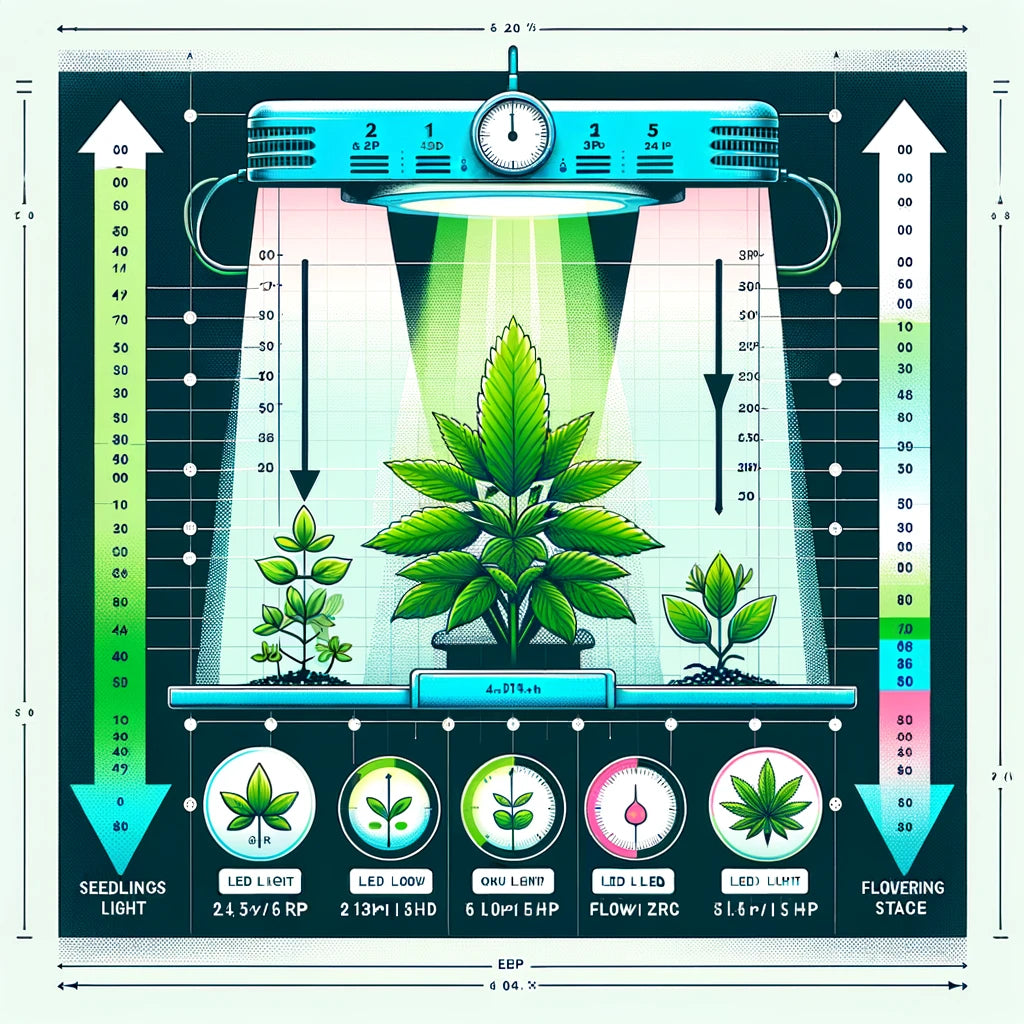LED Grow Light Distance Chart: Optimal Placement for Maximum Growth

Indoor gardening has seen a remarkable transformation with the advent of full-spectrum LED grow lights. These innovative lighting solutions replicate the diverse wavelengths of natural sunlight, providing plants with the ideal conditions for photosynthesis and growth. However, achieving the best results requires more than just installing these lights. One crucial factor often overlooked is the proper management of light distance.
This article delves into the world of full-spectrum LED grow lights and provides an invaluable distance chart to optimize plant growth and yield.
Understanding Full Spectrum LED Grow Lights
Full-spectrum LED grow lights have revolutionized indoor cultivation by offering a balanced light spectrum that resembles sunlight. Unlike traditional lighting systems, which emit specific wavelengths, full-spectrum LEDs provide a broad range of light from ultraviolet to infrared. This enables plants to undergo photosynthesis efficiently throughout their entire lifecycle, from seedling to flowering.
The Science Behind Full Spectrum LED Lights
The concept of full-spectrum LED lights is rooted in understanding how different light wavelengths affect plant physiology. Plants use light primarily for photosynthesis, the process by which they convert light energy into chemical energy to fuel growth. Different wavelengths of light trigger specific responses in plants. For instance:
Blue light (400-500nm): Stimulates vegetative growth and is crucial for promoting strong, compact plants.
Red light (600-700nm): Enhances flowering and fruiting stages, encouraging robust blossoms and higher yields.
UV light (280-400nm): Triggers the production of protective compounds, helping plants resist pests and diseases.
IR light (700-1000nm): Facilitates efficient photosynthesis and overall plant metabolism.
Benefits of Full Spectrum LED Grow Lights
Energy Efficiency: Full Spectrum LED lights are more energy-efficient than traditional HID (High-Intensity Discharge) lights. They emit light in specific wavelengths that plants can readily absorb, reducing the wastage of energy in the form of heat and unused light.
Customizability: Modern full-spectrum LED lights often come with adjustable settings, allowing growers to tailor the light spectrum and intensity according to the specific needs of their plants. This flexibility is particularly advantageous for different growth stages.
Compact Design: Full Spectrum LED lights are compact and easily mounted or suspended, optimizing space utilization in indoor gardens.
Longevity: LED technology boasts an impressive lifespan, saving growers from the frequent bulb replacements associated with traditional lighting systems.
Heat Management: Unlike traditional lights, which can emit excessive heat, full-spectrum LED lights produce minimal heat. This feature eliminates the risk of scorching or stressing plants.
Applications of Full Spectrum LED Grow Lights
Indoor Gardening: Full Spectrum LED lights are a boon for indoor gardening enthusiasts, enabling them to cultivate a wide range of plants, from herbs and vegetables to ornamental flowers, inside their homes.
Commercial Agriculture: Full-spectrum LED lights in large-scale agriculture are gaining traction, especially in regions with limited sunlight or extreme weather conditions. These lights allow for year-round crop cultivation and higher yields.
Research and Scientific Studies: Full spectrum LED lights play a pivotal role in research settings, where scientists can manipulate light conditions to study plant responses, optimize growth, and develop new agricultural techniques.
Full Spectrum LED Grow Light Distance Essentials
Factors Affecting Light Distance
Mastering the art of light distance management involves considering several key factors:
Light Intensity: Light intensity decreases as the distance from the source increases. Finding the right balance is crucial to prevent light burn or insufficient light exposure.
Plant Growth Stage: Different growth stages demand varying light intensities. Seedlings require gentler light while flowering plants need more intense illumination.
Specific Plant Species: Different plant species have varying light requirements. Some plants thrive with higher light levels, while others prefer milder illumination.
Manufacturer's Recommendations: Manufacturers often provide guidelines for optimal light distances based on product specifications. These recommendations are valuable starting points for growers.
The Importance of the Right Distance
Proper light-distance management is a fundamental aspect of successful indoor gardening. Incorrect distances can lead to a range of issues:
Light Burn: Placing plants too close to the light source can result in a light burn, causing plant stress and hindering growth.
Stunted Growth: Inadequate light exposure due to improper distances can lead to stunted growth and leggy plants.
Reduced Yield: Plants that don't receive the right light may produce fewer flowers or fruits, ultimately impacting the yield.
Light Bleaching: Excessive light intensity can lead to light bleaching, where leaves lose their vibrant color and vitality.
Full Spectrum LED Grow Light Distance Chart
Here's a comprehensive distance chart to help you determine the optimal placement of your full-spectrum LED grow lights at various growth stages:
Growth Stage: Distance from Plants
Germination: 24 - 36 inches
Seedling: 18 - 24 inches
Vegetative: 12 - 18 inches
Pre-flowering: 8 - 12 inches
Flowering: 6 - 10 inches
Fruiting: 6 - 12 inches
Tips for Effective Distance Management
Achieving the perfect light distance involves a combination of science and observation. Here are some actionable tips to help you master this art:
Use a Light Meter: Invest in a light meter to accurately measure light intensity and make informed adjustments.
Adjust Height as Plants Grow: As your plants grow taller, adjust the light height to maintain the optimal distance.
Regularly Monitor Plant Health: Keep a close eye on your plants' overall health and growth. Any signs of stress or inadequate lighting should prompt you to reevaluate the light distance.
Refer to Manufacturer's Guidelines: Always consult the manufacturer's recommendations for their specific LED grow lights. These guidelines provide valuable insights into the ideal light distance for your plants.
Mastering the art of full spectrum LED grow light distance management is essential for successful indoor gardening. By understanding the factors influencing light distance, referring to the comprehensive distance chart, and implementing practical tips, you'll be well-equipped to provide your plants with the optimal conditions they need to thrive.
You can experiment, observe, and fine-tune your approach as you witness your indoor garden flourish under the gentle glow of full-spectrum LED grow lights.




